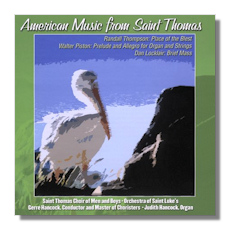
The Internet's Premier Classical Music Source
Related Links
-
Locklair Reviews
Piston Reviews
Thompson Reviews - Latest Reviews
- More Reviews
-
By Composer
-
Collections
DVD & Blu-ray
Books
Concert Reviews
Articles/Interviews
Software
Audio
Search Amazon
Recommended Links
Site News
 CD Review
CD Review
American Music from Saint Thomas

- Dan Locklair:
- Brief Mass
- Pater Noster
- Walter Piston: Prelude & Allegro for Organ & Strings
- Randall Thompson: The Place of the Blest
Judith Hancock, organ
Saint Thomas Choir of Men and Boys
Orchestra of St. Luke's/Gerre Hancock
Koch KIC-CD-7567 52:52
Summary for the Busy Executive: Very nice.
Saint Thomas Episcopal Church in New York City has one of the most prestigious choirs in the country. It's a fairly rare ensemble in the United States, at any rate: an all-male choir with boy trebles. The choir takes from the Anglican tradition of cathedral choirs, even to the point of providing free, very good schooling for the treble choristers. Actually, the ensemble seems to me on the verge of disappearing even in England, since cathedral choirs have begun to admit girls. High time, too, considering that free, very good education. As far as I can tell, the British choirs that have done this sound no different from the all-male groups, so for me there's little musical reason to keep the status quo.
Almost all the choral music was composed for Saint Thomas. Piston composed the Prelude and Allegro for E. Power Biggs and a CBS première (remember when public television was educational television and even the networks had pretensions to kulcha?). Piston, as usual, writes well and idiomatically for the instruments in his elegant, high neoclassic style. Contrary to my usual biases, I prefer the slow Prelude to the Allegro. The latter seems less focused.
Master choral composer Randall Thompson's Place of the Blest cantata comes from the last part of his career. By this time, disenchanted with the current trends of composition, he had largely withdrawn from writing for professional venues. The cantata, for sopranos and altos with a chamber ensemble, takes large risks, because it is superficially so uncomplicated. Rather than hiding behind complex harmonies and textures, Thompson makes his points through beautiful melodies and exquisitely clear and simple contrapuntal "fills." Thompson has chosen wonderful, out-of-the-way texts as well: Herrick's "Carol of the Rose" and "The Place of the Blest" surround Richard Wilbur's recreation ("translation" fails to do justice to Wilbur's achievement) of Philippe de Thaun's "Pelican" (1120). Thompson gives the Wilbur the most modern and rhythmically intricate setting and still brings off something that sounds "natural." Thompson's considerable art successfully hides itself. The "Carol" and "Place" are melodies where every note and chord seem perfectly placed.
Having heard some of Dan Locklair's organ music, I have begun to explore his other work. So far, wonderful pieces jostle with the nothing-much, certainly the case here. I've got nothing against Locklair's setting of the Pater Noster, but I forget it a minute after hearing it. Not so with the Brief Mass, a lively, heartfelt work, written on the death of a colleague. Locklair keeps his ideas simple and memorable. The interest of the work derives from a sophisticated sense of harmony and rhythm. The Credo particularly impresses me. Essentially a political checklist, that part of the Mass always struck me as the hardest to set expressively. The text breaks down into atomistic bits, as one tenet of the faith follows another almost willy-nilly. Beethoven solved the problem in his Missa Solemnis by elaborating each bit almost to the breaking point and elevating disunity to a structural principle in the work. However, Locklair's setting makes overall rhetorical sense and drives toward the finish.
The Orchestra of St. Luke's needs no puff from me. Judith Hancock does a fine job in Piston's solo part. The choir differs from the classic English cathedral sound. The boys sound like boys rather than like bloodless angels, and in general the choir executes rhythms more crisply. However, they trade a less creamy blend for these things. Gerre Hancock, a well-respected choirmaster, conductor, organist, and authority on church music, makes music. He impresses particularly in the Locklair mass. I found the program lovely and the performances up to the music.
Copyright © 2010, Steve Schwartz.




















